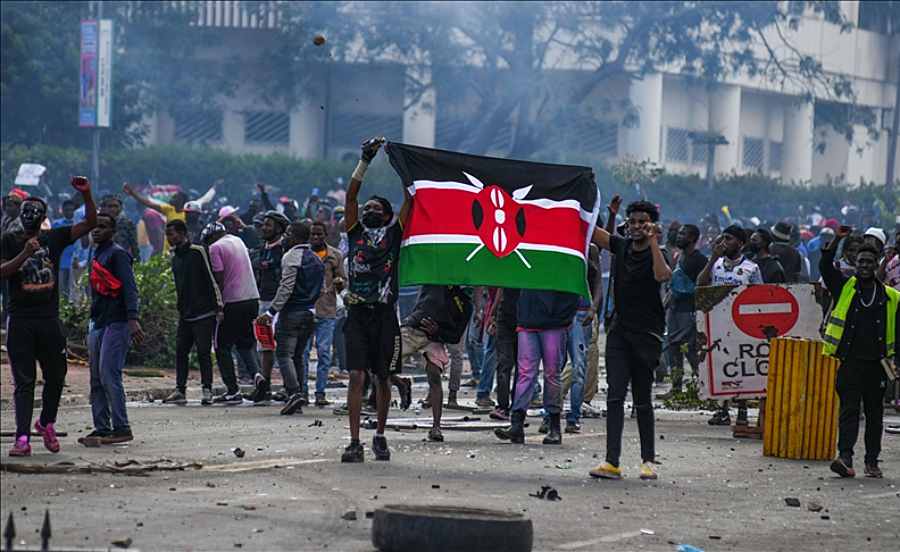Thu 01 August 2024:
– Despite the government backtracking on unpopular tax hikes, protesters now demand deeper measures to remedy economic disparities and government accountability
– ‘To address these protests, the government needs to take tangible steps towards transparency, initiate meaningful reforms, and engage in genuine dialogue with the protesters. Without these actions, the unrest is likely to persist and potentially escalate,’ political analyst Simon Mukhwana tells Anadolu
NAIROBI, Kenya
Kenya’s streets remain a battleground as protests, sparked by controversial tax hikes, evolve into a wider outcry against deep-rooted economic disparities and a perceived lack of government accountability.
At the forefront of this movement is a generation of young Kenyans, refusing to be silenced despite facing escalating police crackdowns.
The protests erupted earlier this year in response to a government-proposed finance bill that included a slew of tax hikes amidst an already challenging economic environment.
The bill sparked public outrage, particularly among young people, who saw it as a move that would exacerbate an ongoing cost of living crisis in the East African nation. Widespread claims of government corruption and mismanagement only added fuel to the flames.
Kenyan President William Ruto bowed to the ensuing pressure by firing almost his entire Cabinet and initiating the process of building a new one. Despite this and other government concessions, the demonstrations have shown no signs of abating.
__________________________________________________________________________

https://whatsapp.com/channel/0029VaAtNxX8fewmiFmN7N22
__________________________________________________________________________
Youth in the spotlight
Young Kenyans, have been at the forefront of the demonstrations. Armed with smartphones and social media savvy, they have mobilized with remarkable speed and agility, bypassing traditional media channels to organize, share information, and galvanize support for protests calling for Ruto’s resignation.
Many express a sense of fearlessness, born from witnessing years of political corruption and economic hardship.
“This is not just about taxes anymore, the protests have changed into what the youth feel they need and they are not backing down. It will be tough to bring the protests to a stop until they get what they want,” explains Wandia Njoya, a political analyst at Daystar University. “It’s about a generation demanding a better future, one where they are not perpetually marginalized.”
The demonstrations began in June, ignited by widespread frustration over government corruption and economic mismanagement. Young people expressed their anger by burning down a section of the parliament building during the initial wave of protests.
Every Tuesday and Thursday, Kenyans assemble on the streets to protest, frustrating the government, often met with a heavy police response. To date, 50 people have been killed in confrontations with law enforcement, according to the state-owned Kenya National Commission on Human Rights.
Sheila Mwangi, a 24-year-old activist, is determined to continue protesting. “We are tired of empty promises. We have so many unresolved issues with this government,” she says. “We want real change, not just for ourselves but for future generations.”
Their grievances extend beyond the now-withdrawn finance bill, encompassing broader issues such as unemployment, police brutality, and lack of government accountability. “We don’t want people from the old Cabinet back, and we want the president to step down. We’ve endured years of broken promises and corrupt leadership,” Mwangi added.
According to human rights activist David Karanja, police brutality has been a significant rallying point for the protesters. “The government’s heavy-handed approach has only strengthened the resolve of the youth to continue their fight,” he said.
Karanja noted that the regular demonstrations have become a powerful symbol of the people’s determination to hold the government accountable and demand a better future.
However, he pointed out a significant challenge: “However, the leaderless nature of the movement presents a significant challenge.
“Without a central figure or organized leadership, coordinating efforts and negotiating with authorities becomes difficult.”
On the streets of Nairobi, Kenyans voiced different sentiments on how the protests can come to an end.
Amina Hassan, a 21-year-old university student said, “As students, we are the future of this country, and we refuse to inherit a broken system, Kenya is standing at a critical juncture, a make-or-break moment.”
“We are protesting because we want quality education, job opportunities, and a government that listens to our voices. We will not stop until we see genuine change,” she said.
Many protesters, like high school teacher Grace Wanjiru, are on the streets for a better future for their children.
“They deserve an education system that prepares them for success, not one hindered by political instability and lack of funding. We are fighting for their future and our own. The only way this can stop is if all demands are met,” she said.
The path forward
Besides these hopeful sentiments, uncertainty prevails on how the country will go forward, with many possible scenarios looming.
According to political analyst Simon Mukhwana, if confrontation between protesters and the government fails to subside, this could lead to prolonged instability and further economic disruption.
Alternatively, authorities could offer more substantial concessions, he said, admitting also that it will take significant reforms to address the deep-rooted structural issues in the government.
The worst-case scenario could see the situation spiral into violence, potentially resulting in a prolonged and bloody conflict.
“The protests are a culmination of years of pent-up frustration and anger among the populace,” Mukhwana explained.
“People are fed up with the pervasive corruption, economic hardships, and lack of accountability from the government. The return of figures from the old Cabinet has only added fuel to the fire, as it shows a continuation of the same failed policies and leadership,” he said, adding:
“The path forward remains uncertain but to address these protests, the government needs to take tangible steps towards transparency, initiate meaningful reforms, and engage in genuine dialogue with the protesters. Without these actions, the unrest is likely to persist and potentially escalate.”
As Kenya stands at a critical juncture, civic groups and international observers have called for immediate dialogue between the government and the protesters to avoid risks of deeper chaos. The emphasis is on creating a platform where grievances can be addressed constructively, and a roadmap for reforms can be established.
-Source: AA
______________________________________________________________
FOLLOW INDEPENDENT PRESS:
WhatsApp CHANNEL
https://whatsapp.com/channel/0029VaAtNxX8fewmiFmN7N22
![]()
TWITTER (CLICK HERE)
https://twitter.com/IpIndependent
FACEBOOK (CLICK HERE)
https://web.facebook.com/ipindependent
YOUTUBE (CLICK HERE)
https://www.youtube.com/@ipindependent
Think your friends would be interested? Share this story!





